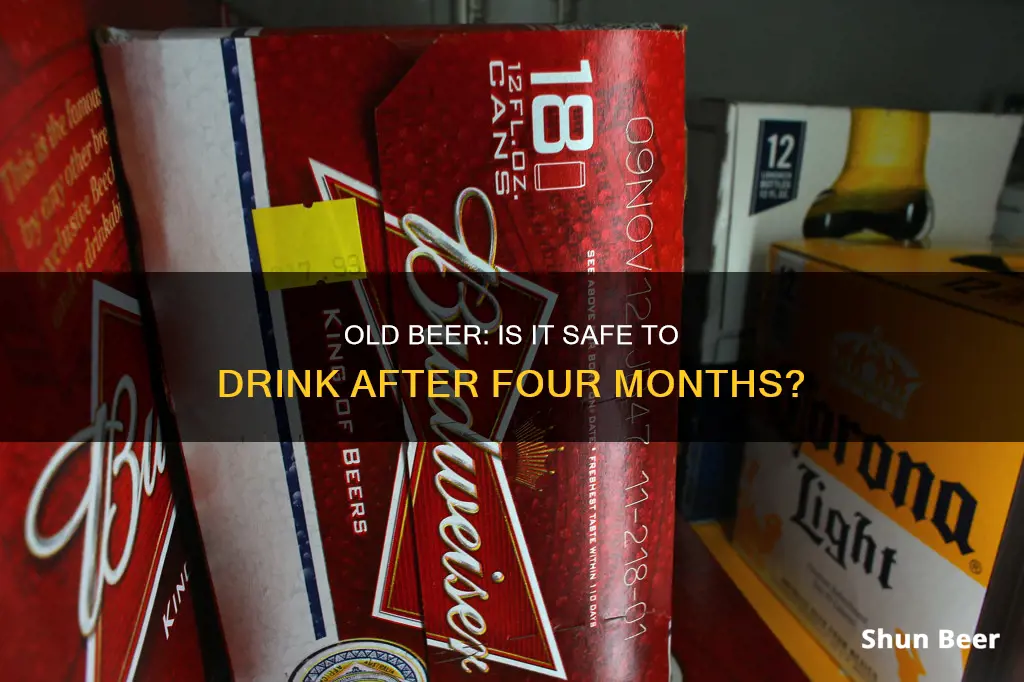
Beer typically has a 'best before date, which is a guideline on quality rather than safety. Drinking beer past this date is usually safe, but the flavour may have changed. Beer with higher alcohol content tends to have a longer shelf life. However, light body, low ABV beers tend to have their flavour deteriorate faster than darker, high ABV beers. Additionally, the way beer is packaged is important as light and oxygen break down the flavours in beer. Canned beer will do much better over extended periods than bottles.
| Characteristics | Values |
|---|---|
| Safety | Drinking 4-month-old beer is generally safe, as the alcohol content and hops prevent harmful bacterial growth. |
| Taste | The beer may not taste good due to oxidation, which can cause stale, bitter, or "skunky" flavours. |
| Aroma | Volatile hop aromas tend to dissipate over time, resulting in a weaker or non-existent aroma. |
| Texture | The beer may become flat and lose its usual fizz or carbonation. |
| Appearance | Excessive sediment at the bottom of the bottle can indicate that the beer has turned. |
| Storage | Beer should be stored in a cool, dark, and dry place, preferably in a refrigerator, to maintain freshness and prevent spoilage. |
What You'll Learn
- Beer doesn't typically 'expire' in a way that will make you sick
- The flavour of beer can deteriorate over time, especially in lighter beers
- Stouts and porters can improve with age, like wine
- IPAs are best enjoyed fresh, as they lose their flavour and aroma over time
- Storing beer in a cool, dark place can help maintain its quality

Beer doesn't typically 'expire' in a way that will make you sick
Beer is unlikely to make you sick past its expiration date, even if it has been stored for years. This is because the alcohol content in beer, and the presence of hops, which have antimicrobial properties, prevent pathogenic growth. The worst thing that will happen is that the beer will taste bad.
The flavour of beer can change over time. High-gravity beers, like barley wines or imperial stouts, are sometimes brewed with aging in mind. These beers can develop richer flavours as they slowly oxidize. However, low-gravity beers tend to become stale much more quickly.
To keep beer from diminishing in quality, it is recommended to check the expiration date and store it in the fridge until you are ready to drink it. If you don't have space, keep it in the coolest, darkest part of your house, like a cool basement or cellar.
While exposure to light and repeated temperature fluctuations can negatively affect the flavour of beer, the hops and alcohol in beer generally prevent bacterial growth that can cause sickness. To keep your beer fresher for longer, it is best to keep it cold and out of direct sunlight and drink it within a couple of months of purchase.
Antibiotics and Beer: A Safe Mix?
You may want to see also

The flavour of beer can deteriorate over time, especially in lighter beers
The rate at which beer deteriorates depends on various factors, including the type of beer, packaging, and storage conditions. Stronger beers, such as stouts, porters, and high-alcohol content beers, tend to last longer than lighter beers. Beers packaged in clear or green bottles are more prone to oxidation and will have shorter expiration dates. On the other hand, darker bottles and cans offer better protection from light exposure, helping to preserve the beer's quality for longer.
Proper storage is crucial to maintaining the flavour of beer. Beer should be stored in a cool, dark place, away from temperature fluctuations, and upright to minimise oxidation. Following these guidelines can help slow down the deterioration process and preserve the beer's flavour.
Additionally, the serving temperature of beer can also impact its flavour. When served too cold, the temperature can mask many flavours and aromas, resulting in a thin and tasteless experience. On the other hand, warm beer allows more flavours and aromas to come to the forefront, but as it approaches room temperature, the sensations from hop bitterness and carbonation can decrease, leading to a flat-tasting experience. Therefore, different types of beer have suggested serving temperatures to optimise their flavour profiles.
Priming Your Beer: The Science Behind Carbonation
You may want to see also

Stouts and porters can improve with age, like wine
While most beers are best consumed fresh, stouts and porters are among the few styles that can improve with age. Beers with high alcohol content (8% ABV or higher) tend to hold up best when aged, and stouts and porters fall into this category. The high alcohol content protects the beer from oxidation, while the bold and intense flavours develop into even more complex notes over time.
Stouts and porters can be aged for 10 or more years, but it's important to store them correctly. Beer should be stored in a cool, dark place, ideally at 55 degrees Fahrenheit or lower, and away from any light sources. Additionally, beer should be stored upright to prevent yeast and sediment from settling.
Aged stouts and porters can develop rich, complex flavours, with notes of raisin and prune that can taste wonderful. However, ageing beer is an inexact science, and it can be hard to know when to open a stashed beer. Too early, and the flavours might not have had time to develop; too late, and the beer could be past its prime.
If you're thinking of ageing a stout or porter, it's worth drinking a bottle fresh first to get a baseline for its flavours. Then, try another bottle after six months, a year, and so on, to see how the flavours develop over time.
Beer Taxes: Effective or Just a Burden?
You may want to see also

IPAs are best enjoyed fresh, as they lose their flavour and aroma over time
Beer doesn't typically "expire" in the same way that milk does. However, IPAs are best enjoyed fresh, as they lose their flavour and aroma over time.
IPAs, or India Pale Ales, are particularly sensitive to the passing of time because they contain a large amount of hops, which are responsible for the beer's bitterness, flavour, and aroma. When exposed to ultraviolet light, heat, and oxygen, the hops in IPAs begin to lose their flavour-enhancing power. As a result, the beer will taste less bitter and may take on a malt or caramel flavour.
To ensure that you're getting the freshest IPA possible, it's best to buy beer that has been stored cold and will remain cold until you drink it. It's also important to check the date of production, as IPAs are best enjoyed within three weeks to three months of being produced. If you're buying an IPA from a store, it's best to avoid big box stores and places that sell beer alongside ping pong balls, as these stores may not prioritise the quick sale of beer.
If you're looking for an IPA that will taste fresh, even after a few months, you might want to try a West Coast IPA. West Coast IPAs tend to have a longer shelf life than their East Coast counterparts due to their heavier use of hops and higher ABV. However, no matter the type of IPA, it's always best to enjoy them as fresh as possible to appreciate the complex flavours and aromas that the brewers have intended.
The Magic of Beer Thieves: How Do They Work?
You may want to see also

Storing beer in a cool, dark place can help maintain its quality
Storing beer in a cool, dry, dark place can help maintain its quality. Beer is best stored at a temperature that is slightly above the temperature you would serve it at. For instance, strong beers like barley wines and imperial stouts are ideally served at around 12-16°C, so these should be stored at or slightly above this temperature.
The reason for this is that heat will accelerate the chemical reactions that cause the beer to break down over time. Heat can also cause the production of dimethyl sulfide (DMS), which can give the beer a cooked-vegetable or cooked-corn flavour and aroma. It can also cause the breakdown of yeast, resulting in a flavour and aroma similar to burning tyre rubber.
Fluctuations in temperature are not ideal, but re-chilling a beer that has been previously refrigerated will not significantly impact its quality.
It is also important to keep beer out of direct sunlight, as this can cause a chemical reaction in the beer, breaking down its flavour components and causing it to smell and taste like skunk spray. This is why beer bottles tend to be dark-coloured.
It is also recommended that beer is stored upright, as this limits the amount of beer that is exposed to oxygen, slowing the rate of oxidation.
A Beginner's Guide to Joining a Beer Crawl
You may want to see also
Frequently asked questions
Yes, drinking 4-month-old beer is generally safe, as the alcohol and hops in beer act as preservatives, preventing bacterial growth. However, it is recommended to consume beer within 6 months of its manufacturing date for the best results.
Beer that has gone bad will have a bad aroma, a lack of the usual 'pssst' sound when opened, and excessive sediment at the bottom of the bottle.
The flavour of beer can be impacted by factors such as the beer style, packaging, light exposure, temperature, and freshness at the time of purchase. Light body, low ABV beers tend to have their flavour deteriorate faster than darker, high ABV beers.
Yes, if the beer was refrigerated when purchased, it is best to continue storing it in the fridge. Changes in temperature can adversely affect the flavour of the beer.







